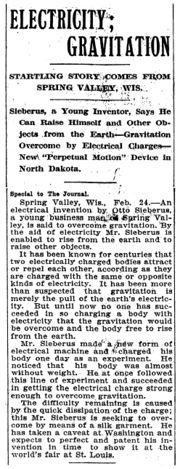Otto Sieberns
From Kook Science
Press Coverage
- "ELECTRICITY; GRAVITATION - STARTLING STORY COMES FROM SPRING VALLEY, WIS. - Sieberus, a Young Inventor, Says He Can Raise Himself and Other Objects from the Earth — Gravitation Overcome by Electrical Charges", Minneapolis Journal (Minneapolis, Minn.): 10, 24 Feb. 1904
Special to The Journal.
Spring Valley, Wis., Feb. 24. — An electrical invention by Otto Sieberus, a young business man of Spring Valley, is said to overcome gravitation. By the aid of electricity Mr. Sieberus is enabled to rise from the earth and to raise other objects.
It has been known for centuries that two electrically charged bodies attract or repel each other, according as they are charged with the same or opposite kinds of electricity. It has been more than suspected that gravitation is merely the pull of the earth's electricity. But until now no one has succeeded in so charging a body with electricity that the gravitation would be overcome and the body free to rise from the earth.
Mr. Sieberus made a new form of electrical machine and charged his body one day as an experiment. He noticed that his body was almost without weight. He at once followed this line of experiment and succeeded in getting the electrical charge strong enough to overcome gravitation.
The difficulty remaining is caused by the quick dissipation of the charge; this Mr. Sieberus is seeking to overcome by means of a silk garment. He has taken a caveat at Washington and expects to perfect and patent his invention in time to show it at the world's fair at St. Louis.
- "Heat Exchange", Star Tribune (Minneapolis, Minn.): 14, 3 July 1907, https://www.newspapers.com/newspage/178895688
According to the Spring Valley Sun, Mayor Otto Sieberns of that town has perfected an invention that promises to revolutionize the weather in the summertime. The Sun describes the new process as follows:
Even on the hottest day, a mile or two above us is cold air in abundance. Cold air sinks, hot air rises; yet the blanket of hot air next to the earth prevents the cold air from falling, unless a tube or hole be made for the cold air to fall through. The invention, in brief, is this: Using the hot air near the ground to inflate a lifter, a tube of two feet or less in diameter is raised until it pierces the cold air above us; the air is then pumped out of the tube, forming a descending current of cold air. Action, once started, is automatic — the cold air rushes out of the bottom of the tube, and the hot air rises, keeping the tube in place. Suitable valves control the flow.
We fear the Sun is giving us its own hot air.
